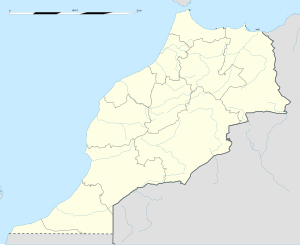Port Lyautey
|
Kenitra القنيطرة / Qniṭra |
||
|---|---|---|

Avenue Mohamed Diouri, Avenue Mohamed V, Kenitra
|
||
|
||
| Location in Morocco | ||
| Coordinates: 34°15′N 6°35′W / 34.250°N 6.583°W | ||
| Country |
|
|
| Region | Rabat-Salé-Kénitra | |
| Province | Province of Kénitra | |
| Founded | 1912 | |
| Government | ||
| • Mayor | Aziz Rabbah (PJD) (2009) | |
| Area | ||
| • Total | 76 km2 (29 sq mi) | |
| Population (2014) | ||
| • Total | 431,282 | |
| Time zone | WET (UTC+0) | |
| • Summer (DST) | WEST (UTC+1) | |
| Website | http://www.alkenitra.com/ | |
Kenitra (Moroccan Arabic: قْنيطره, Qniṭra; Arabic: القنيطرة, al-Qonayṭéra, the little bridge) is a city in northern Morocco, formerly (1932–1956) known as Port Lyautey. It is a port on the Sbu river, has a population in 2014 of 431,282, is one of the three main cities of the Rabat-Salé-Kénitra region and the Chef-lieu of the Province of Kénitra. During the Cold War Kenitra's U.S. Naval Air Facility served as a stopping point in North Africa.
The history of the city begins with the foundation of a trading-post by the Phoenicians, known back then as Thamusida. Under the Antonine dynasty, a Venus temple was built there.
Before the French protectorate, there was only a kasbah in the area where the modern city can today be found.
In March 1912 the French government and the Sultan of Morocco, Abd al-Hafid, signed the Treaty of Fez. Because of his growing unpopularity, the Sultan asked the French government for protection against the Berber rebel tribes surrounding Fez. France appointed Hubert Lyautey resident-general in Morocco.
...
Wikipedia


